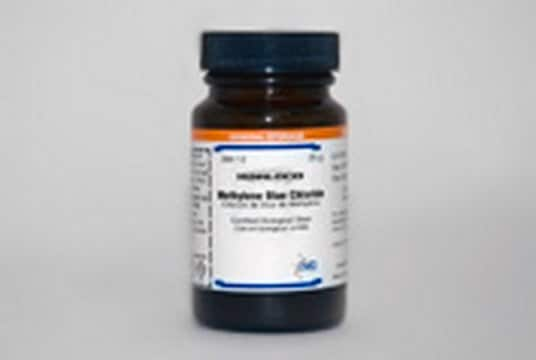Yes, in addition to biological stain applications, Methylene Blue is also commonly used as a redox indicator. Oxidized solutions will appear blue in color and will turn colorless when mixed with a reducing agent. A reduced or clear solution will turn blue when exposed to an oxidizing agent. Methylene blue is considered a basic dye, but not commonly used as an pH indicator. Methyl Blue, which is a chemically different compound, is more commonly used as a pH indicator. Please see the link below to review this compound:
https://www.sigmaaldrich.com/product/sial/95290
M9140
Azul de metileno
Dye content, ≥82%, certified by the Biological Stain Commission, powder
Sinônimo(s):
Azul básico 9, Cloreto de 3,7-bis(dimetilamino)fenazatiônio, Cloreto de tetrametiltionina
About This Item
Produtos recomendados
Nome do produto
Azul de metileno, certified by the Biological Stain Commission
grau
certified by the Biological Stain Commission
Nível de qualidade
Formulário
powder
composição
Dye content, ≥82%
técnica(s)
microbe id | staining: suitable
cor
dark green
solubilidade
H2O: 4mg/4ml
aplicação(ões)
diagnostic assay manufacturing
hematology
histology
temperatura de armazenamento
room temp
cadeia de caracteres SMILES
CN(C)C1=CC=C2C(SC(C3=N2)=CC(C=C3)=[N+](C)C)=C1.[H]O[H].[Cl-]
InChI
1S/C16H18N3S.ClH.H2O/c1-18(2)11-5-7-13-15(9-11)20-16-10-12(19(3)4)6-8-14(16)17-13;;/h5-10H,1-4H3;1H;1H2/q+1;;/p-1
chave InChI
WQVSELLRAGBDLX-UHFFFAOYSA-M
Informações sobre genes
human ... CYP1A2(1544) , GSR(2936)
Procurando produtos similares? Visita Guia de comparação de produtos
Descrição geral
Aplicação
Ações bioquímicas/fisiológicas
Adequação
Palavra indicadora
Warning
Frases de perigo
Declarações de precaução
Classificações de perigo
Acute Tox. 4 Oral
Código de classe de armazenamento
11 - Combustible Solids
Classe de risco de água (WGK)
WGK 3
Ponto de fulgor (°F)
Not applicable
Ponto de fulgor (°C)
Not applicable
Equipamento de proteção individual
dust mask type N95 (US), Eyeshields, Gloves
Escolha uma das versões mais recentes:
Certificados de análise (COA)
Não está vendo a versão correta?
Se precisar de uma versão específica, você pode procurar um certificado específico pelo número do lote ou da remessa.
Já possui este produto?
Encontre a documentação dos produtos que você adquiriu recentemente na biblioteca de documentos.
Os clientes também visualizaram
Artigos
Serotonin is stored in cells and metabolized by MAO, influencing CNS, GI, and platelet functions.
-
Is this ingredient suitable for use as a redox indicator? What is the main difference compered to that used as an indicator?
1 answer-
Helpful?
-
-
Which is the granulometry of this powder?
1 answer-
The quality control testing only requires that the methylene blue powder appear as a powder. There is no requirement to define the powder as either coarse, medium or fine powder.
Helpful?
-
-
Is there any information available on ammonium molybdate's role in fixing methylene blue dye?
1 answer-
There is no information available regarding the use of ammonium molybdate for mixing methylene blue staining.
Helpful?
-
-
Is there any testing conducted for lead and other heavy metals in any of the available methylene blue products?
1 answer-
Medicinal grade and food grade dyes are likely to undergo testing for lead and other heavy metals. It is unlikely that Methylene Blue is offered as a food grade dye. M9140 is not subjected to testing for lead and other heavy metals because it is not intended for human or veterinary use.
Helpful?
-
-
Are various powdered methylene blues suitable for marking brain regions in live mice? There are issues visualizing it after staining, suspected due to outdated methylene blue. Assistance is required in choosing the right type for preparation for identifying specific brain regions.
1 answer-
There is no mention of which methylene blue has been problematic. Biological dyes usually lack expiration dates. The recommended catalog number is M9140, which is certified by the Biological Stain Commission (BSC) for staining nuclei blue using paraffin sections and for staining bacteria in milk. Other applications of Methylene Blue include staining white blood cells in Wright Stain, oversight staining, supra vital staining, and staining nerves, nerve fibers, neuronal processes, live non-neuronal cells, tumors, and as a surgical marker.Fresh and aged dyes can yield different reactions. Effective solutions may need fresh preparation. Some dyes have set expiration dates due to deterioration. While using two blue dyes is unusual; thionin is commonly used for Nissl staining.
Helpful?
-
-
How can Methylene blue, Product M9140, be used?
1 answer-
Probably its most important application is as an in vitro diagnostic bacteriology, cytology, hematology, and histology stain. Methylene Blue serves as a precursor to the Methylene Azures and as a component of the various Ramanowsky-type blood stains (Wright, Leishman, Giemsa and others). While pure Methylene Blue is not a good nuclear stain, it readily undergoes oxidative demethylation to form the various Methylene Azures, which are good nuclear stains.
Helpful?
-
-
What is the Department of Transportation shipping information for this product?
1 answer-
Transportation information can be found in Section 14 of the product's (M)SDS.To access the shipping information for this material, use the link on the product detail page for the product.
Helpful?
-
-
What is the solubility of Methylene blue, Product M9140?
1 answer-
The product is soluble in water at 50 mg/mL, EGME at 60 mg/mL and ethanol at 70 mg/mL. EGME is an abbreviation for ethylene glycol monomethyl ether, also known as 2-methoxyethanol or methyl cellosolve.
Helpful?
-
-
How is dye content determined for Methylene blue, Product M9140?
1 answer-
Dye content is determined spectrophotometrically by noting the dye's absorbance peak, which is typically near 665 nm, or by calculating the ratio of the absorbances at 650 nm over 680 nm. (The dye exhibits smaller peaks at approximately 292 and 246 nm).
Helpful?
-
Active Filters
Nossa equipe de cientistas tem experiência em todas as áreas de pesquisa, incluindo Life Sciences, ciência de materiais, síntese química, cromatografia, química analítica e muitas outras.
Entre em contato com a assistência técnica




